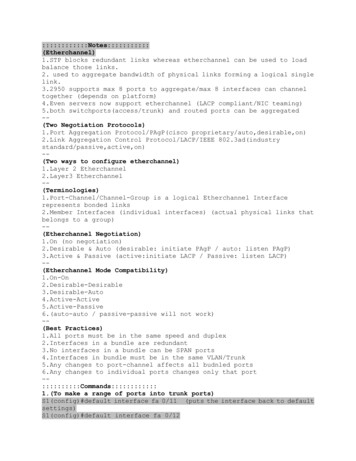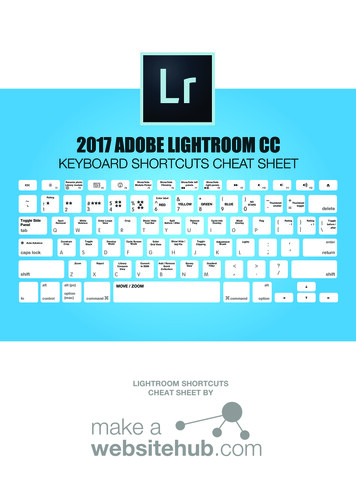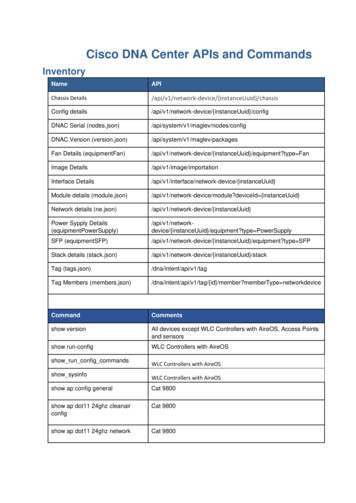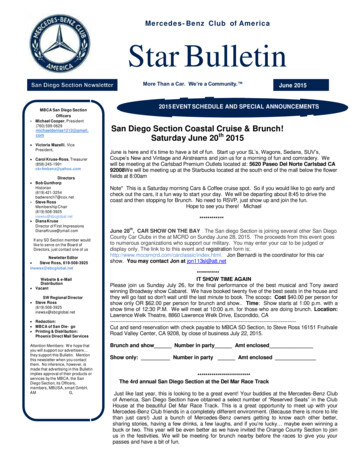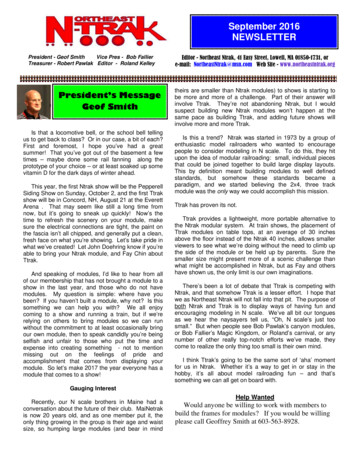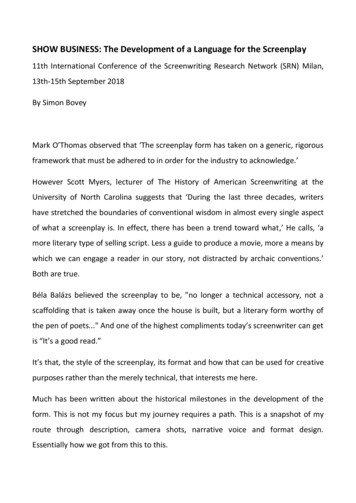
Transcription
SHOW BUSINESS: The Development of a Language for the Screenplay11th International Conference of the Screenwriting Research Network (SRN) Milan,13th-15th September 2018By Simon BoveyMark O’Thomas observed that ‘The screenplay form has taken on a generic, rigorousframework that must be adhered to in order for the industry to acknowledge.’However Scott Myers, lecturer of The History of American Screenwriting at theUniversity of North Carolina suggests that ‘During the last three decades, writershave stretched the boundaries of conventional wisdom in almost every single aspectof what a screenplay is. In effect, there has been a trend toward what,’ He calls, ‘amore literary type of selling script. Less a guide to produce a movie, more a means bywhich we can engage a reader in our story, not distracted by archaic conventions.’Both are true.Béla Balázs believed the screenplay to be, "no longer a technical accessory, not ascaffolding that is taken away once the house is built, but a literary form worthy ofthe pen of poets." And one of the highest compliments today’s screenwriter can getis “It’s a good read.”It’s that, the style of the screenplay, its format and how that can be used for creativepurposes rather than the merely technical, that interests me here.Much has been written about the historical milestones in the development of theform. This is not my focus but my journey requires a path. This is a snapshot of myroute through description, camera shots, narrative voice and format design.Essentially how we got from this to this.
.2‘The first scripts.merely indicated what was to be in the picture, and in what order’,writes Balázs, ‘but said nothing about how it was to be presented.’ Such as thescenario for Georges Méliès A Trip to the Moon from 1902 where the pre-productiondocument is little more than a shot list.The first major step toward the screenplay we know today was the need to defineintellectual property rights. In 1904 the American Mutoscope and Biograph Companysued the Edison Company for making an unauthorised remake of one of their films. Acase AM&B won meaning that on the 25th November 1904 a scenario called TheSuburbanite received the first registration in the new classification of ‘dramaticcomposition.’ The screen play was born.One of the figures most closely associated with the early development of thescreenplay is Thomas Harper Ince. ‘Under him,’ writes Marc Norman, the screenplaywas ‘no longer simply a one-page precis of the film’s narrative but the blueprint forthe entire production.’ C. Gardner Sullivan, a writer under contract to Ince, suggestedthat ‘each scene in our continuity is practically a short story in itself they are so fullydescribed.’This is a page from Sullivan’s screen play Satan McAllister's Heir, and you can see itgives a sense of the tone. Some mise-en-scene, design and, most interestingly,information that the audience couldn’t deduce from the screen.Both Steven Price and Scott Myers refer to elements like this as unfilmables. ClaudiaSternberg calls this the ‘comment’ mode, an indicator of the authorial persona ornarrative voice. To Ann Igelström it is the ‘impersonal fictional voice.’ Allowing us, asPrice expanded, to focus not so much on how a screenplay conforms to a system but,rather, how variations within it reveal ‘the individualism of the author.’
.3But both Hague and Hunter, in their respective books, suggest a rule that ‘only thosethings that are to appear on the screen should appear within the scene text.’ Is this aconundrum? Screenwriter Larry Ferguson relates an anecdote about the producerDon Simpson who told him he loved the style of his description in Beverly Hills Cop II.He said ‘We know we can’t shoot them, but we can shoot the tone.’ It is after all thescreenwriters’ storytelling sensibility. And any demonstration of emotion orpsychology that can be interpreted by other creatives will find its way onto thescreen. This is the purpose of the screenplay. A quality of text that lies somewherebetween Elaine Scarry’s definitions of delayed sensory content - that which is“instructions for the production of actual sensory content,” and mimetic content that which is figuratively there.For example this is a page from Sunrise. It’s pithy and imagistic much like a haiku. Iespecially like ‘Asphalt vapor.’ It has the ability to arouse both the visual and theolfactory sense.The form became largely standardised within the Hollywood of the 1920’s, but asPrice and others have noted, the hasty conversion to sound spawned many ad hocformatting solutions.A Research Council was convened within the Hollywood Industry in 1932 to try anddetermine a ‘form of script that will be most legible, graphic, and convenient inpractical use’. The style that won most favour was the Warner Brothers’ template.This is a page from The Desert Song which shares many recognisable characteristicsto the screenplay in use today.
.4However different styles persisted well into the 50’s. On the left is from Wizard of Ozwith large paragraphs detailing technical description and an aside NOTE to the readeras to story architecture. Notorious some seven years later however, is still clearlybroken down into well-defined shots.She Wore a Yellow Ribbon is emotively descriptive and starts to define shots withinthe action lines with hyphens. A technique still popular today. By way of a contrastthis page from Bad Day at Black Rock illustrates the MGM style that favours thedialogue over the indented action lines.Perhaps the biggest influence towards the form we know today was the ‘ParamountCase’ of 1948 which provided the platform for the selling or ‘Spec’ script. A SupremeCourt anti-trust ruling separated production from exhibition. This meant filmcompanies lost their guaranteed market. Having talent under contract no longermade financial sense and screenwriters were now working for independentproducers or sometimes just themselves.Stylistically, according to analysis of 43 screenplays Claudia Sternberg claims that,after this screenplays tended to contain less detailed camera instructions. Myanalysis of close to 200 from the same period fails to confirm this. Though Iacknowledge, as Marc Norman notes, that as screenwriters started to becomeuntethered from the necessities of production their style also became more literary.This was a gradual change and one that had marked impact on the look of the page.The Quiet Man from 1952 uses comment mode in a NOTE to the reader similar to Ozbut this details delightful character tactics and advice to the creatives as to how thescene should be played.
.5Compare this to an oft cited example of a pivotal screenplay, Bonnie & Clyde, thatsome suggest was one of the first 'specs', where the same function is elegantlyplayed out within the action lines. ‘They have lived so much in cars ’ Could this bededuced just from watching the screen? Perhaps not. But actors can play it.William Goldman may be the first to take a jokingly conversational attitude to hisreader, in Butch Cassidy and the Sundance Kid. His knowing asides and metaobservations about John Wayne delightfully illustrate the feel and tone of thenarrative. This is a style that we will see much more of in the late eighties and itpersists today. Its A Mad, Mad, Mad, Mad World considers not so much the reader orthe creatives but what they believe will be the emotional effect on the audience. Inthe extreme end of the literary this excerpt from The Graduate shows a passage thatwould not have appeared out of a place in a novelisation.As we progress Marc Norman reflects that the 70’s were a boom time forscreenwriters. ‘As often as not, screenwriters took the development risk ontothemselves.’ Which meant they had relative freedom to develop a script in the styleof their choosing. Two very contrasting examples are the formatting peculiarities ofThe Godfather with its turned around headings and boxed in scenes. And here we’restarting to see clearly the breaking up of paragraphs and each sentence a shot. Onthe other side Big Wednesday has camera frame headings, like Notorious, but alsouses hyphenates and comment mode that captures the exultation of the surf.One writer that really stands out in this period is Walter Hill. Narrative style in hisscreenplay The Driver is clear, crisp and uninflected. A basic explanation of what theshot will contain. It owes more to a shot list than a treatment. Hill himself said ‘I triedto write in an extremely spare, almost haiku style, both stage directions anddialogue.’ It seems to me that it is closest to Murnau’s Sunrise than anything in thepreceding sixty years.
.6By the end of the 1970s however ‘a dominant discourse around screenwriting wasbeginning to insist that authorial narration.was inadmissible.’ explains Price. ‘Shotspecification, too, would be prohibited.’ He and Norman note at this time the rise offilms indebted to reproducible story templates and the profusion of screenwritingmanuals. Steven Maras claims ‘the distinctiveness of the screenplay is elusive.’ Butwith the release in the early eighties of screenwriting software, Scriptor being amongthe first, you start to arrive at something like a consensus.One of the most profound changes was the rise and dominance of the spec scriptwithin the market and with it, The Reader or Analyst. Joe Eszterhas called them deathto serious writing. But the producer Brian Morewitz said “coverage is an institution inthe entertainment world.”And to stand out writers took to exploiting the comment mode and the master of thisapproach in the early 90’s was Shane Black, whose style irked David Mamet so muchthat in 1996 he wrote an article for the L.A. Times Magazine excoriating coveragereaders and the effect they have had on screenwriters trying to grab their attention.These are two such style bombs from Lethal Weapon – The kind of house I’ll buy ifthis movie is a huge hit, and from The Last Boy Scout – Good morning Mr and MrsAmerica and Yes honey that’s your butt These excesses could not be sustained orsurvive their imitators, but they do leave a legacy.Corley and Megel wrote that ‘more attention to the language of visual description inscreenplays, and more conscious, less mechanical, use of format in screenwriting, is abenefit to the end product of the screenplay: the film itself. ‘
.7And everything I have mentioned I believe brings us to this point. These are pagesfrom two recent screenplays. Kate by Umair Aleem and The Mother by Misha Green.Miserly short sentences. Verbs and nouns wielded like stings. The left hand rule usedlike warfare, the readers’ eye flicking back to the left to create a fast read. They owea debt to Murnau and to Hill. Note the smooth transition of location in The Mother.In 1992 Ron Bass said the screenwriter ‘traditionally serves the directors vision’ butnow screenwriters have finally turned what looked like demotion from anything todo with the camera into control. Corley and Megel again, wrote that ‘it is importantto match the rhythm on the page with the rhythm of the film we are trying to write.’Evidence this from The Empty Man by David Prior. The pace is created by use ofFrench Scenes, slow, full of tension then single spaced short lines show it rack upseveral gears.This specificity is the screenwriters’ and the formats task. If the shot is a travellingone, such as this famous track shot from Goodfellas. Then write that. If it’s a close up,like this from Jurassic Park, you don’t have to write close up just write what you see.Karl Iglesias said of the screenwriting craft that it is ‘the technical ability to controllanguage to create an intentional emotion or image in the reader’s mind.’ That beingso The Bourne Supremacy of 2004, exhibits its application at a high level with a virtualshot by shot translation from page to screen. It has that mimetic quality that ElaineScarry talks about where we feel it viscerally while reading. And lots of hyphens!This can be extended to the degree that the screenwriter defines the entireproduction model. This is an excerpt from the recent screenplay The Fall by PeteBridges which is ‘Real time. One shot.’ Edited only by the track of the camera across amaster scene.
.8The format itself projects the film into your head. This is thoughtful page design.Trottier may tell us that it is passé to capitalise sounds so Dwain Worrell in Fortressuses underlining, bold and italics to produce a page that looks dynamic and exciting.Autobahn by Scott Frazier takes this a step further with a graphic representation ofduration of sound, and meta comments like Goldman – maybe that kind of thing onlyworks in movies.Hold the Dark by Macon Blair, uses repetition and bold to create a clear visualexpression of the aural impact he wishes the film to make. Very much what Howardand Mabley had in mind when they wrote that ‘The screenwriter must have consciousintentions for what the audience will see and hear and, most important, experiencewhen the script is cast and produced.’ As in here in Will O’Wisp where repetition isused to chilling effect to replicate a flicker book.And once again software is having an impact on formatting styles. Fade Inscreenwriting software is currently the only one with an image insert function. Thewriters of the recent A Quiet Place used it to boldly illustrate their screenplay. This isan approach that is growing in use.But it is still a small step however next to Mad Max: Fury Road, an incomparablyvisual read that is a hybrid of screenplay, storyboard and graphic novel. Also a veryfaithful page to screen translation.Fade In also allows screenwriters to change the scale of the font to create meaning.Take Back The Night by Ryan Riley does this to suggest volume and intensity. First offists on the left, then of voice on the right. Perhaps more radical is the text effects inNightcrawler, increasing font size gives the sense of rising tension to hysteric levels.This page resembles more concrete or image poetry than anything. And finally TheBabysitter by Brian Duffield uses it to well, create shock.
.9That’s a good place to conclude. This is a work in progress, but even so I hope I havethrown some light on the changes of screenplay style, and how it is currently themost refreshing and exciting writing to read.
screenplay is Thomas Harper Ince. ZUnder him, [ writes Marc Norman, the screenplay was Zno longer simply a one-page precis of the films narrative but the blueprint for the entire production. [ C. Gardner Sullivan, a writer under contract to Ince, suggested . The Godfather with its turned around headings and boxed in scenes. And here were




